Iowa Lakes Corridor's GROWTH Program

18 Jul 2025
Iowa, Business, Regionalism, News, Business Retention and Expansion, Economic Development
Iowa Lakes Corridor's GROWTH Program Serves a Core Economic Function for Regional Progress
The Iowa Lakes Corridor Development Corporation doesn't treat Business Retention & Expansion (BRE) as an afterthought. It is a core function of the region's economic development strategy. Through its GROWTH program, an acronym for Gather, Relationships, Opportunities, Wins, Trends, and Hometown, the Corridor team maintains close ties with existing employers, uncovers expansion opportunities, and coordinates solutions to workforce, housing, and infrastructure challenges across Clay, Dickinson, Emmet, and Buena Vista counties.
.png)
This strategic, data-driven effort goes far beyond basic outreach. In 2024, the Corridor conducted 105 visits, accounting for 11% of all BRE visits reported to the State of Iowa. That level of engagement demonstrates the Corridor's commitment and capability.
As part of this work, the Iowa Lakes Corridor partners closely with the Iowa Economic Development Authority (IEDA) to share business intelligence and ensure consistency in data collection. Some of the questions used in local BRE surveys come directly from IEDA, enabling statewide benchmarking and more informed decision-making at every level. Every quarter, the Corridor shares aggregated data with the state, including insights on expansion plans, industry sectors, infrastructure barriers, international sales, ownership changes, and sustainability goals.
"The strong relationships and trust Corridor staff have built with local businesses, through years of consistent, personal engagement, are the key to the high level of success and involvement we see from our business community," said Curt Strouth, President and CEO of the Iowa Lakes Corridor Development Corporation.
BRE Data Reveals Strong Business Confidence Across the Corridor
The Corridor's most recent BRE survey findings provide a clear snapshot of local business health and the scale of future investment:
- 36% of businesses plan to expand within the next three years
- 65% have introduced new products or services in the last five years
- 62% report stable or increasing merger and acquisition activity
- 54% have active sustainability goals
- Capital investment of $230+ million and more than 290 new jobs expected in the next three to five years
Businesses across industries, including advanced manufacturing, retail, agriculture, transportation, and professional services, are planning for growth and actively pursuing innovation. Local employers are reinvesting in their facilities, adopting new technology, and tapping into global markets. Nearly 25% of companies reported international sales activity, and 5% of all surveyed businesses generate between 21% and 40% of their revenue from global markets.
“The data we collect from our local businesses is instrumental in shaping our priorities for the years ahead,” said Joanne Follon, Business Retention & Workforce Partnership Coordinator. “For example, when we see that more than a third of businesses are planning to expand, it clearly signals where we should concentrate our efforts. That might mean strengthening talent pipelines through partnerships with local educational institutions, attracting new talent to the region, improving site infrastructure, or streamlining permitting processes and working closely with our cities, counties, and utility partners. This kind of insight allows us to make more informed decisions and stay closely aligned with the real needs of businesses across Clay, Dickinson, Emmet, and Buena Vista counties.”
Workforce Challenges Are Significant, but so Is the Regional Response

Hiring remains the top concern across the region. Of the businesses surveyed:
- 57% are experiencing recruitment issues
- 383 open positions were reported
- Workforce availability scored just 2.36 out of 5 on average
- 40% of businesses are working directly with schools on workforce strategies
Rather than waiting on external solutions, many employers are taking proactive steps by partnering with local schools and community colleges. The Corridor is facilitating these connections and helping businesses tap into resources like workforce training programs and K-12 career awareness initiatives.
The Corridor team also recognizes that workforce challenges extend beyond hiring and recruitment. Housing, affordable and available childcare, and upskilling are critical factors influencing regional talent attraction and retention. According to business leaders surveyed:
- 69% identified workforce housing as a community challenge
- 45% pointed to talent attraction
- 42% called out childcare as a critical need
- 40% emphasized the need for workforce upskilling
The Corridor is working closely with local governments, housing developers, and education providers to address these gaps and build the necessary infrastructure for long-term population and business growth.
The Regional Model Builds Trust and Delivers Results
The Corridor's approach to BRE is grounded in deep local knowledge and long-term relationship-building. Joanne Follon, who leads BRE for the region, brings 17 years of experience in economic development to the role. Her approach is personal, strategic, and data-informed. Every business visit is documented. Follow-ups are prioritized. Resources are matched to real-world needs.
Technology plays a supporting role. The team uses tools like EDC Forge Smart Solutions to manage scheduling, surveys, and Customer Relationship Management (CRM) data. But the program's success stems from what happens face-to-face: listening, observing, and building trust.
During interviews and surveys, businesses are clear about what they need. Topics include site readiness, broadband, utility reliability, and access to capital. The Corridor team compiles these insights into a final deliverable report, which is shared with stakeholders and used to align efforts across county lines. This report becomes a living document for action, not just a static summary.
BRE Drives Growth Because It's Designed To
When 36% of companies say they're planning an expansion, that's not a data point. It's a promising indicator of future economic development opportunities. BRE is the front line for identifying these projects early and helping them materialize through site support, permitting guidance, workforce connections, and incentives.
The Iowa Lakes Corridor doesn't view BRE as a support function. It is a core strategy for regional competitiveness. It is the reason the region secured over $230 million in projected capital investment last year and expects to create hundreds of new jobs in the coming years.
Use BRE Data To Guide Policy and Investment
Iowa Lakes Corridor's GROWTH program is a regional planning resource. Community leaders, policymakers, and investors can use Corridor BRE data to:
- Quantify market opportunities by industry
- Identify infrastructure bottlenecks
- Prioritize workforce housing developments
- Strengthen education-to-employment pipelines
- Allocate resources for high-impact projects
Talk to the Corridor Team About Using BRE Insights to Strengthen Your Community
BRE is focused on gathering actionable data and building strategic relationships. If your company, agency, or municipality wants to coordinate more effectively on business retention and workforce development, connect with the Iowa Lakes Corridor team.
More Topics


Priority Health Northwest is Helping to Provide More Healthcare Options in Northwest Iowa
Jun 19 2025




